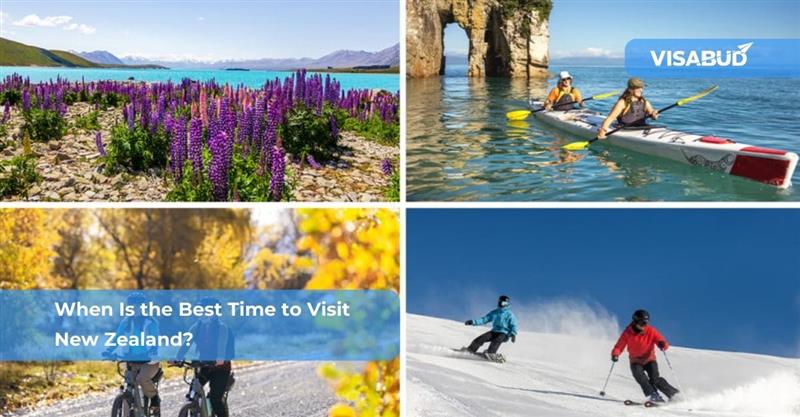New Zealand is a country known for its breathtaking landscapes and a wide range of activities to enjoy, making it a great destination no matter when you visit. The right time to go really depends on what kind of experience you’re looking for. Whether you’re into adventure sports, scenic views, or cultural events, choosing the best time to visit will make your trip even better.
New Zealand’s seasons are opposite to those in the Northern Hemisphere. Summer, which runs from December to February, is the warmest time of the year. It’s perfect for outdoor activities like hiking, going to the beach, or trying adventure sports such as bungee jumping and jet boating. However, because it’s peak season, you’ll find that tourist spots can be crowded, and prices for accommodations and tours may be higher.
Autumn (March to May) is another great time to visit. The weather is still pleasant, and the landscapes are stunning with beautiful fall colors. It’s also harvest season, so if you love wine, it’s a great time to visit the vineyards. The crowds are smaller compared to summer, which makes it a more peaceful and enjoyable experience.
Winter (June to August) is perfect for anyone who loves snow and skiing.New Zealand has some amazing ski resorts, especially in places like Queenstown and Wanaka. It’s also a good time for enjoying hot springs in places like Rotorua.
Spring (September to November) brings mild weather and blooming flowers, making it an ideal time for outdoor activities without the crowds of summer.
Understanding New Zealand’s Seasons
New Zealand, located in the Southern Hemisphere, experiences seasons that are opposite to those in the Northern Hemisphere. This means that the best time to visit will depend on the kind of experience you’re looking for. Each season offers unique weather conditions, activities, and atmospheres, so when you visit will have a significant impact on your overall experience.
Summer in New Zealand runs from December to February. During this time, the weather is warm and sunny, making it perfect for outdoor adventures like hiking, beach visits, and water activities. The summer months are also the busiest, with tourists flocking to popular destinations, so you can expect larger crowds and higher prices for accommodations and activities.
Autumn takes place from March to May, and it’s considered one of the most beautiful times to visit. The weather remains mild, and the landscapes are transformed with vibrant shades of red, orange, and yellow. Autumn is also the harvest season, making it a fantastic time to explore vineyards and enjoy local wine. The crowds are smaller compared to summer, offering a more peaceful atmosphere, and you can often find better deals on accommodations and tours.
Winter lasts from June to August and is the best time for snow sports. The ski resorts in places like Queenstown and Wanaka come alive with visitors looking to enjoy skiing, snowboarding, and other winter activities. If you enjoy cozy winter vibes, hot springs, and fewer tourists, winter is a great choice.
Spring, from September to November, offers mild temperatures and beautiful blooms, making it a wonderful time for outdoor exploration without the summer crowds. The weather is ideal for hiking and sightseeing, with nature coming to life after the winter chill.
Summer (December to February)
Summer in New Zealand, which spans from December to February, is the country’s peak travel season, and it’s easy to see why. The weather during these months is warm and sunny, with temperatures ranging from 20°C to 30°C, making it the perfect time for outdoor adventures. Whether you’re hiking through the stunning landscapes, cycling along scenic trails, or relaxing at one of New Zealand’s beautiful beaches, the summer months offer plenty of opportunities to explore. With long daylight hours, you’ll have more time to enjoy the breathtaking views and natural beauty of the country.
New Zealand’s vibrant festivals also take place in summer, adding to the festive atmosphere. Christmas and New Year’s celebrations bring excitement, with outdoor barbecues, concerts, and fireworks lighting up the summer nights. If you’re looking to experience the country’s lively culture, the summer months are filled with events and celebrations that showcase New Zealand’s unique traditions and local flavor.
For adrenaline junkies, summer is the perfect time to indulge in adventure sports. Queenstown, known as the “Adventure Capital of the World,” offers thrilling activities like bungee jumping, skydiving, and jet boating. Whether you’re seeking high-energy adventures or simply looking to relax in the great outdoors, New Zealand has something for everyone.
Autumn (March to May)
Fantastic time to visit New Zealand if you prefer to avoid the summer crowds while still enjoying comfortable weather. From March to May, temperatures range from around 10°C to 25°C, which means the hot summer days have passed, but the weather is still warm enough for outdoor activities. The cooler temperatures create a more relaxed and pleasant atmosphere for exploring the country’s diverse landscapes.
One of the highlights of autumn in New Zealand is the incredible fall foliage. The landscapes in places like Central Otago and the Southern Alps are transformed with vibrant shades of red, orange, and yellow. These colorful scenes make for perfect photography opportunities and peaceful nature walks. Whether you’re hiking or simply taking in the views, autumn provides some of the most beautiful landscapes of the year.
If you’re a wine enthusiast, autumn is the ideal time to visit New Zealand’s famous wine regions, such as Marlborough and Hawke’s Bay. This is harvest season, so you can visit vineyards, tour wineries, and taste fresh local wines. The vineyards are bustling with activity, and it’s an exciting time for wine lovers to experience the process firsthand.
Winter (June to August)
Winter in New Zealand, which lasts from June to August, is the perfect season for snow sports enthusiasts. During these months, the country’s ski fields are in full operation, attracting skiers and snowboarders to popular destinations like Queenstown, Wanaka, and the Southern Alps. The temperatures typically range from 0°C to 15°C, and while it can be quite chilly, the cold weather brings plenty of snow to the mountainous regions, making it an ideal time for skiing, snowboarding, and other winter activities.
For those who aren’t into snow sports, winter in New Zealand offers other relaxing experiences. One of the best ways to enjoy the cold season is by visiting the country’s famous hot springs, particularly in places like Rotorua and Hanmer Springs. These geothermal spas provide a warm escape from the chilly weather, offering a soothing and unique way to unwind after a day outdoors. The combination of the winter chill and the warm, mineral-rich waters creates a perfect contrast, making it a memorable experience.
Winter in New Zealand is also marked by several exciting festivals, such as the Queenstown Winter Festival. This event celebrates everything winter has to offer, including music, food, and fun activities, making it a great way to enjoy the season’s festive spirit.
Spring (September to November)
Spring in New Zealand (September to November) is a beautiful time of year, as the country shakes off the winter chill and welcomes the new season. During this period, temperatures typically range between 10°C and 20°C, offering mild and comfortable weather perfect for outdoor activities such as hiking, cycling, and exploring the many parks and gardens. The season is also marked by vibrant floral displays, with stunning gardens like the Christchurch Botanic Gardens and the Hamilton Gardens showcasing a colorful array of blooming flowers.
One of the main advantages of visiting New Zealand in spring is the relaxed atmosphere. Compared to the busy summer months, spring sees fewer tourists, allowing for a more peaceful experience when visiting popular attractions. This makes it easier to enjoy the country’s natural beauty without large crowds. Whether you’re strolling through alpine meadows or walking along the coast, you’ll be able to appreciate the fresh, vibrant surroundings in a way that feels more intimate and personal.
Spring is also an ideal time to visit New Zealand’s wine regions. As the vineyards begin to bud and the local produce comes into season, it’s a great opportunity to explore the country’s renowned wineries. The weather can be a little unpredictable at times, so layering clothes is important to stay comfortable throughout the day. Despite the occasional rain, the overall atmosphere in spring is refreshing and enjoyable.
Regional Considerations
New Zealand’s diverse geography means that the best time to visit can vary depending on the region you’re planning to explore. The North Island and South Island have distinct climates, so the ideal travel time will depend on your destination within the country.
Special Events and Festivals
New Zealand is known for its vibrant cultural scene, and throughout the year, the country hosts various festivals and special events that showcase its rich heritage and traditions. These events can play a big role in deciding when the best time to visit is, depending on your interests.
One of the most significant events is Waitangi Day, celebrated on February 6. This national holiday commemorates the signing of the Treaty of Waitangi in 1840, a key moment in New Zealand’s history. On this day, you’ll find ceremonies, cultural performances, and community celebrations across the country, especially in Waitangi, where the treaty was signed. It’s a great time to experience New Zealand’s Maori culture and history.
In June, the Queenstown Winter Festival kicks off the ski season in style. This lively event features a variety of activities, from concerts and performances to ski races and fireworks. It’s the perfect time for winter sports enthusiasts to visit and enjoy both the celebrations and the skiing conditions in one of New Zealand’s most popular alpine destinations.
Another important cultural event is Matariki, the Maori New Year, which falls between June and July. Matariki is celebrated with a mix of traditional Maori customs, including feasts, storytelling, and cultural performances. It’s a wonderful opportunity to immerse yourself in the indigenous culture and learn about the Maori calendar and their connection to nature.
In spring, which spans from September to November, many regions in New Zealand celebrate the arrival of flowers and fresh produce with local festivals. These festivals highlight the country’s horticultural beauty and are an excellent choice for visitors who want to experience the natural bloom of New Zealand’s gardens and orchards.
Frequently Asked Questions (FAQs)
1. What is the best time to visit New Zealand for outdoor activities?
The best time for outdoor activities in New Zealand is during the summer months, from December to February. The weather is warm, and there are plenty of daylight hours to enjoy hiking, beach activities, and adventure sports like bungee jumping and jet boating.
2. Is it worth visiting New Zealand in winter?
Yes, winter (June to August) is perfect for snow sports enthusiasts. If you enjoy skiing, snowboarding, or simply love winter landscapes, then visiting New Zealand during this time is ideal. Popular ski destinations like Queenstown and Wanaka offer excellent slopes and après-ski experiences.
3. What is the weather like in New Zealand during autumn?
Autumn, from March to May, offers mild weather, making it a great time to visit if you prefer cooler temperatures without the crowds. The highlight of autumn is the stunning foliage, with vibrant reds, oranges, and yellows painting the landscape, especially in the Central Otago region and vineyards.
4. How crowded is New Zealand in the summer?
Summer (December to February) is New Zealand’s peak tourist season, so popular spots like Queenstown, Auckland, and Rotorua can get crowded. If you don’t mind the busier atmosphere and higher prices, it’s still a fantastic time to visit for outdoor adventures and festivals.
5. Is spring a good time to visit New Zealand?
Spring (September to November) is a wonderful time to visit. The temperatures are mild, and the landscape is bursting with flowers. The crowds are also fewer compared to summer, so it’s a great option if you want to enjoy New Zealand’s natural beauty in a more peaceful setting.
6. What are the best places to visit in New Zealand during the winter?
During winter, the South Island is a must-visit, especially for snow sports in Queenstown, Wanaka, and Mount Hutt. Rotorua, with its hot springs, also provides a warm escape from the chilly weather. The winter months are perfect for exploring New Zealand’s ski resorts and enjoying cozy activities.
7. Are there any festivals or events that happen throughout the year?
Yes, New Zealand has a vibrant calendar of festivals and events. The summer months are packed with music festivals, outdoor events, and cultural celebrations. The Auckland Arts Festival (March) and the New Zealand International Film Festival (July) are notable, while the Queenstown Winter Festival in June offers a fun winter experience with live music, parades, and fireworks.
Conclusion
In the end, the best time to visit New Zealand truly depends on what kind of experiences you want to have. Each season brings its own unique charm, offering different opportunities for adventure and relaxation. Summer, from December to February, is a popular time to visit. The long, sunny days are perfect for outdoor adventures like hiking, beach outings, and trying adrenaline-packed sports like bungee jumping and jet boating. However, as it’s the peak tourist season, you can expect more crowds and higher prices in many of the popular spots.
Autumn, which spans from March to May, is another wonderful time to explore the country. The weather remains mild, but the main highlight is the stunning foliage. The forests and vineyards are filled with rich autumn colors, creating a picturesque landscape that’s perfect for photography and peaceful walks. Additionally, autumn is a quieter time to visit, with fewer tourists, which means you can enjoy New Zealand’s beauty at a more relaxed pace.
Winter, from June to August, attracts snow sports enthusiasts, particularly those who enjoy skiing or snowboarding. The ski resorts in Queenstown and Wanaka become top destinations during these months, offering world-class slopes and cozy mountain vibes. Even if snow sports aren’t your thing, winter is a great time to relax in hot springs or explore the country’s winter landscapes.
Spring, from September to November, provides a refreshing atmosphere with milder temperatures and vibrant blooms. It’s the ideal time for outdoor activities like hiking and exploring, without the crowds of summer. The landscapes come alive with color, making it a visually stunning season to visit.
Contact us for detailed travel advice on New Zealand!







